
Artists and craftsmen have always taken their inspiration from what they see and experience. Today's artisans combine traditional techniques with more modern techniques and conveniences and make them their own.
As I come to this with the North American quilting tradition, my work adds yet another facet to ancient techniques. The original craft is, beyond doubt, a masterful work of beauty and skill. Staying true to roots takes more time than most of us have today and so, many of our products include traditonal hand work in combination with machine work. France embraces a rich tradition of textile and needle artistry. Techniques integrated into French textiles have, through the ages, developed locally and take inspiration from the many cultures of Europe and beyond. Landscape hues derive from arid regions like the Garrigue, the terracotta red of clay tiling and the vibrant blues and yellows of the Provencal sun and sea. Palettes include subtle tones of natural linens and cottons as well as bolts of brilliant silk. Linen has been produced in France since the 13th century, linen being more abundant than cotton. Because of its durability, its beauty and its traditional heritage, it is still widely used throughout the southern regions. Quilting in France has been traced to Marseilles in the 15thC. Located near the mouth of the Rhone River on the Mediterranean, it was ideally situated for a thriving textile trade. Soon to follow was a reputation for intricate needlework which advanced and refined techniques like: |
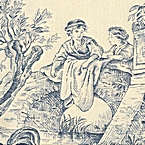 |
TOILE DE JOUY
|
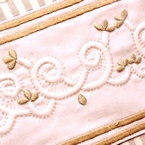 |
TRAPUNTO Originating in Italy, trapunto is a technique also often used in French quilts. Two layers of cotton are stitched together using a simple running stitch to outline narrow channels, through which soft yarn is then threaded to create a raised surface. In earlier times, it was used to add warmth to garments and bedding. Today this technique is used mostly for its aesthetic value. |
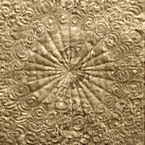 |
FREE MOTION MACHINE QUILTING This emulates a French Quilting technique known as "matelassage". Free motion quilting is a whole cloth quilting technique that sandwiches 3 layers of fabric. There is a backing fabric, a batting, and a plain or patterned top fabric. The 3 layers are then stitched together using a free-motion machine quilting stitch. The authentic French quilting technique known as "matelassage" is always quilted by hand. |
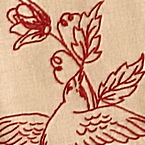 |
REDWORK EMBROIDERY Simple embroidery using only red cotton thread. The name originates from an embroidery thread known as "turkey red". Developed in the 1870's, it became popular for its vibrant red colourfast dye. In modern French shops, redwork is often seen pieced in combination with other fabrics, such as the Toile de jouy, linens and cottons. Vintage linens containing redwork can also be found in the markets. |
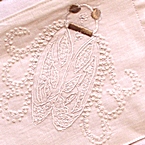 |
WHITEWORK EMBROIDERY White embroidery on a white fabric, such as muslin, linen or batiste, came into fashion in France in the mid 18th century, about the time that the neo-classical revolution reached mainland Europe. Whitework reflects a desire for simpler lines and colours. Again, it was the artisans of Marseilles that popularized this technique, and the women of Marseilles gained a reputation for their beautifully hand-stitched whitework. There is much vintage linen available in the local markets which showcase the skills of these women, mostly with satin stitched monograms. |